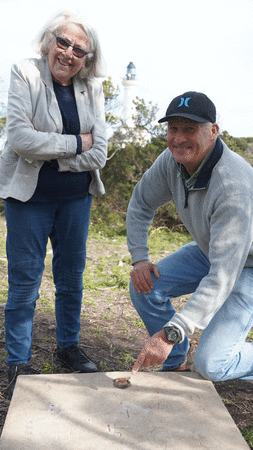 Local historian Jocelyn Grant and Lester Hunt at the site of the war-time inscription discovered near Point Lonsdale lighthouse
Local historian Jocelyn Grant and Lester Hunt at the site of the war-time inscription discovered near Point Lonsdale lighthouse A large concrete slab carrying the inscription of three Australian Women’s Army Service (AWAS) gunners, and sealed with five kisses, was found hidden under heavy vegetation, during a recent clean up of the site.
The scrawled message, dating back to the early 1940s reads:
Gunner Royals, Gunner Alchin and Gunner Thompson. AWAS. XXXXX
Lester Hunt and wife Lynne were walking nearby when the slab was discovered and were immediately aware of its significance.
“During WW2 there were 15 Army Defence buildings on the Reserve plus the concrete searchlight and gun emplacements that many of us still walk past. What is not well know is that there were Australian Women’s Army Service (later Australian Women’s Army Corps) personnel quartered on the east side of the road to the Lighthouse,” said Mr Hunt.
“These young women served as gunners and signalers as part of a unit called the AWAS Coastal Artillery Specialists.
“The Point Lonsdale Lighthouse Reserve has once again unearthed some special insights into the past. The Reserve has always been known by amateur and professional historians and generations of locals to perhaps secretly harbour a treasure trove of relics from its long past.”
Mr Hunt suspects the slab may have covered a well in the vicinity.
The Australian War Museum and Queenscliffe Historical Society have helped to identify the trio, stationed at the Point Lonsdale gun emplacements between 1943-1945.
“The Australian War Museum in Canberra has provided a photo of two of the women, Gunner Alchin and Gunner Thompson on duty in the artillery observation bunker, probably operating a range finding device,” said Mr Hunt.
“Gunner Alchin’s service record has also been found. She was born in 1925, enlisted in 1943, making her 18 years of age when she was stationed at the Lighthouse Reserve.”
Details of the find have also been sent to the Heritage Council of Victoria and could assist with a local campaign to have the reserve heritage listed.
Heritage Victoria has cautioned any similar finds made on the reserve are protected under the Heritage Act and and cannot be disturbed without official consent.
“For me it’s that personal ‘moment in time’ that these women left behind and the fact that were actual gunners in the gun emplacements that got my attention.
“If one or more of these women could be interviewed, well, that would be ‘icing on the cake,” Mr Hunt said.
The National Heritage List includes locations that are of outstanding significance to the nation. They are measured against nine criteria including natural or cultural history, potential to yield significant information and a special association with the life or works of a person or group significant in Australia’s history.
The Queenscliffe Council is currently investigating a request from prominent locals and historians for the site’s inclusion after the federal government indicated its support.